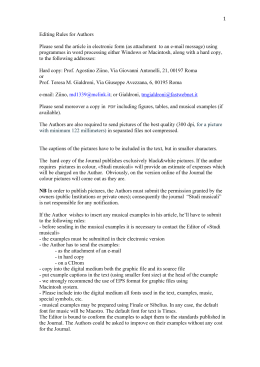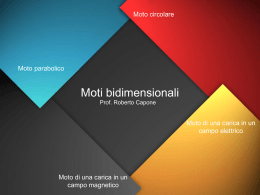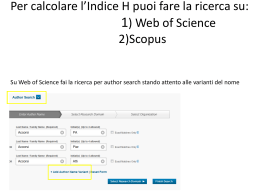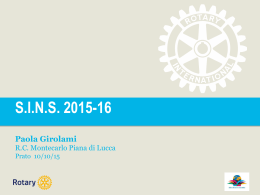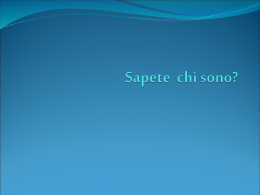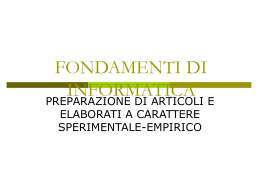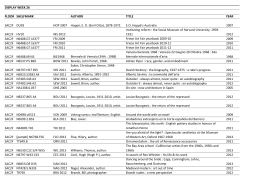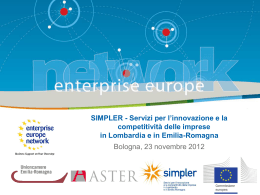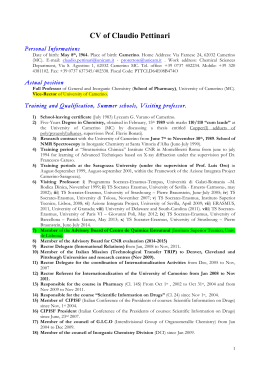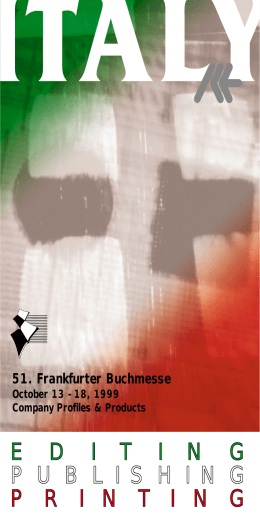Storia urbana Rules for Publications Authors should keep to the following rules for publications: 1) Articles should be sent e-mail to [email protected] 2) Articles must be accompanied by a disclaimer letter in which the author gives the Editors of “Storia Urbana” all rights for commercial use of the article, within the limits fixed by current law (20 years) and with the help of all technologies used currently and in the future. This includes, inter alia, reproduction in all ways and forms, communication – including all rights for patrimonial exploitation through interactive digital channels (with the help of all technologies used currently and in the future) – and distribution of the article. At the same time, the Author grants the Editors exclusively rights for translation, reproduction, communication, distribution of the article in any language, in any way and form; the rights for promotion; the right to grant a third party any rights owing them on the article, in part or in full, on payment or free-of-charge, etc., within the limits fixed by current law (20 years) and with the help of all technologies used currently and in the future. 3) Author’s Name, Surname, Profession, Address and telephone numbers and any note concerning the articles should be clearly indicated and inserted in footnotes in the first page of the article (for these notes, use the symbols * and **; for note within the text, use progressive numbers starting from 1 in each article) 4) There follows an example of the structure of the text and the main rules for publication. TITLE (capital) Author (name and surname, italics)* * Author’s name and surname, profession of author (e.g.: Professor of Architectural Restoration, Faculty of Engineering, University of Brescia). 1. Note text…example (note numbers, not as apex, followed by a full stop). Abstract; in Italian and in English – max 230 words 1. Title of paragraph (lowercase, italics, number of paragraphs in progressive ordernumber followed by full stop, e.g. 1.) Text Font and Size Times New Roman, 12 Notes Footnotes (1) (the reference to the note inside the text to be put in brackets) [Instructions] Names of places and persons in capital. Examples: Catania Amphitheatre, Caracalla Terms, church of S. Maria in Cosmedin, palazzo Maggi Gambara; idem for streets and place names Leave original street and place names, but include English translation in brackets.; e.g. via Vittorio Emanuele (Vittorio Emanuele street), piazza Novarino (Novarino square), Friederickstraße (Frederick street). Spacing Single line Leave two lines at the end of each paragraph. Leave one line after the title of next paragraph Quotes inside the text Quotes to be inserted between French quotation marks « ». If quotations are particularly long leave a line after quoted text. The font of quotation is normal but margins indented. At the end of quotation, leave a line and come back to the dimension of the text; - quotations inside the text of quotation to be put within inverted commas “ ”; - italics to be used for different languages; - to emphasize the meaning of a word ‘ ‘ can be used. «example, example, example, example, quotes inside the text, example, example, “quotes inside quote”, example, example, example, example». Figures and tables The final format of the text is 11.6 cm wide. Tables and figures to be inserted also considering the final dimension. Figures (or images) are in black and white. If necessary, different shades of grey can be used, providing they are not too dense. See, for example, table 1 Table 1 – Title xxxxxxxxx xxx xxxx xxxx xxxx xxxx Sbc Abc Abc Abc Abc Abc 123 123 123 123 123 123 234 234 234 234 234 234 sss 123 123 123 123 123 564 bvc bvc bvc bvc bvc 345 345 345 345 345 345 Images, figures and captions Fig. 1 – example: Catania, view of piazza Stesicoro (Stesicoro square) after the partial discovery of the Amphitheatre (Source: Catania Regional Library) Captions in italics and preceded by Fig. and relative number, as in the example above. Reference to images inside the texts are in brackets (fig. 1). Images to be provided EXCLUSIVELY IN TIFF FORMAT, high solution quality (minimum 300 dpi). Bibliography quotations Volumes In the following order: – Author’s name (punctuate), surname with initial letter in capital (e.g. A. Bruschi). In the case of double name, no space to be put between the initial letter (e.g. G.P. Ferrari). In the case of volumes written by two authors or more, names should be separated by comma. Collective works (more than three authors): first author’s name followed by et al. (e.g. M. Rossi, G. Bianchi, V. Verdi, I bucatini all’amatriciana, Roma, Tipografia il buongustaio, 2010; M. Rossi et al., La coda alla vaccinara, Roma, tip. Il buongustaio, 2010). If the author is unknown, the title of the volume should be quoted directly ; - title of volume, italics; - author or editor, normal font; - editor after the title; - in the case of works printed in more than one volume, number of volume should be indicated (e.g.: voll. I-XII); - publisher or, if missing, printer; - place of printing, followed by the year (or years) of printing; - for works printed in more than one volume, the quoted volume, should be indicated with the cardinal number, followed by the year of printing in brackets; - number of quoted page or pages if necessary (e.g.: p. 12 or pp. 5-15) Examples: G. Baglione, Le vite de’ pittori, scultori et architetti. Dal Pontificato di Gregorio XIII fino a tutto quello d’Urbano VIII, Andrea Fei, Roma 1642, p. 156. Storia e conservazione dei centri storici. Il caso Ortigia, a cura di A. Giuffré, Laterza, Roma-Bari, 1994, pp. 57-65. M. Bucci, Palazzi di Firenze, voll. I-IV, Vallecchi, Firenze 1971-1973, III, pp. 15 ss. Essays in collective volumes In the following order: - author/s’s name and surname, as shown above; - title of essay, italics; - title of the volume, italics, preceded by in; - editor/s’s name (following the same indication for author’s name); - printers, place and year of printing; - page numbers of the essay in the volume; - page reference, if necessary. Examples: M. Ferri, A. Pugliano, La conservazione dei preesistenti caratteri architettonici nei completamenti dell’abbazia di S. Martino al Cimino (secoli XV e XVIII), in La tradizione medievale nell’architettura italiana dal XV al XVIII secolo, a cura di G. Simoncini, Olschki, Firenze 1992, pp. 87-96, in part. p. 91. Essays in proceedings or in exhibition catalogues In the following order: - author’s name and surname (as above); - title of essay (as above); - title of the volume (as above); - to specify that they are proceedings (between inverted comma “ “) or exhibition catalogues, including place and year of congress or exhibition; - editor or editors; - publisher, place and year of volume printing, as above; - page numbers of the essay in the volume; - page references, if necessary, preceded by in part. Examples: J. Shearman, Il mecenatismo di Giulio II e Leone X, in Arte, committenza ed economia a Roma e nelle corti del Rinascimento (1420-1530), atti del convegno (Roma 1990), a cura di A. Esch e C.L. Frommel, Einaudi, Torino 1995, pp. 213-242, in part. p. 216. S. Valtieri, Gli interventi di Sisto V nell’area racchiusa nell’ansa del Tevere, in L’architettura a Roma e in Italia (1580-1621), “Atti del XXIII Congresso di Storia dell’Architettura. Roma, 24-26 marzo 1988”, voll. I-II, a cura di G. Spagnesi, Centro di Studi per la Storia dell’Architettura, Roma 1989, I, pp. 363-371 e figg. 1-8, pp. 557-560. E. Bentivoglio, La cappella Chigi, in Raffaello architetto, cat. della mostra (Roma 1984), a cura di C.L. Frommel, S. Ray, M. Tafuri, Electa, Milano 1984, pp. 125-142, in part. p. 127. Essays in periodicals In the following order: - author’s name and surname (as above); - title of essay (as above); - title of periodical between French quotation marks (e.g.: «Storia Urbana», preceded by in; - indication of the series (e.g.: s. II, or n.s.), where possible; - indication of the year, followed by the date of printing (in brackets) and, after a comma, progressive number of periodical, where possible; - number of fascicle/s, anticipated by f. or ff, where possible; - pages number of essay, as above. Examples: G.P. Treccani, “Liberare i segni di Roma”. Archeologia e centro storico nel caso di Brescia, in «Storia Urbana», XXXII (2009), 124, pp. 63-91 M.G. Aurigemma, Il fiammingo Adriano VI, le arti e la cultura, in «Storia dell’arte», 88 (1996), pp. 321-333. M. Vaquero Pineiro, L’Università dei fornaciai e la produzione di laterizi a Roma tra la fine del ’500 e la metà del ’700, in «Roma moderna e contemporanea», IV (1996), f. 2, pp. 471-494. Works already quoted If the work is being quoted a first time , then author’s name will be followed by title in short (italics), three full stops and cit. (normal font) E.g.: A. Munoz, Roma di Mussolina…, cit., p. 3. Quotation from archival documents In the following order: - Archive or Library see (apart from National Archives; in this case, write, for example, Naples National Archive); - Archive or Library name (normal font). First time quoted in full (followed in brackets by the abbreviation that will be used below), then in short; - It is possible to point out, in a note in the beginning of the essay, which abbreviations are used to indicate archives and libraries. In this case, also the note will be directly in the short form; - name of archival section in full, and in normal font, where possible; - Fascicle number preceded by b; - sheets number, where possible, always preceded by c. or cc. Examples: Gallese, Viterbo, Altemps Archive (AA), b. 68, cc. 137r-143v (at first quote); Verona National Archive (Asvr), Municipal Congregation, Ornate, n. 407; Central National Archive (Asc), Central Direction of Antiquity and Fine Arts, Ist Division (1908-24), b. 1244.
Scarica
